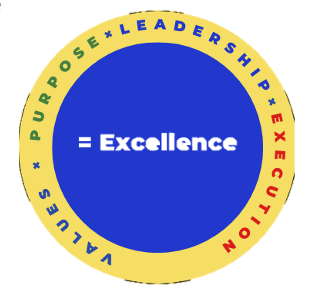A great social observer once said, “All happy families are alike; each unhappy family is unhappy in its own way.” The same sentiment could undoubtedly be applied to organizations.
Recessions and other times of crisis (like global conflicts) have a way of separating happy organizations from those that just talk a good game when the going is good. It’s during the difficult times that organizations show their mettle.
For many organizations, morale becomes low during periods of economic stress, and uncertainty becomes high. The people feel stressed out, demotivated, and lost. In other organizations, employees hunker down, ride out the storm, and build the means for future success.
Happy organizations are aligned in much the same way, but each unhappy organization finds itself in its own unique mess. What is the root cause of that difference? It all comes down to values – the organization’s and the individual’s – and how well those values align or clash.
An economic philosopher of the nineteenth century noted that a company’s success is based on its acquisition and maintenance of “capital.” This statement can still hold today, although perhaps not with its exact meaning 200 years ago.
We have since recognized that a company’s greatest asset is its people or “human capital.” The product alone is no longer the defining means of creating sustainable market differences. The only real competitive advantage comes from your people, specifically how they behave with one another and with your customers, suppliers, and community.
Individuals (and organizations) are defined by how consistently they act in various circumstances. The driving force behind behaviours is our values. Values matter because we are emotional beings. We all seek approval and reinforcement for the things we do. Within organizations, employees win favour from their managers by looking to them for signals that define correct behaviour.
 When the employee’s and the organization’s values are aligned, employees can quickly transfer their behaviours to those of the organization, leading to reinforcement and reward from management. When employees are aligned to the value behaviours, they produce their most outstanding results. But what happens when values are not aligned? When employees know there is a conflict between their behaviours (or what feels comfortable) and the behaviours demonstrated or reinforced by their direct manager, they feel stressed and stretched and can’t be their best selves.
When the employee’s and the organization’s values are aligned, employees can quickly transfer their behaviours to those of the organization, leading to reinforcement and reward from management. When employees are aligned to the value behaviours, they produce their most outstanding results. But what happens when values are not aligned? When employees know there is a conflict between their behaviours (or what feels comfortable) and the behaviours demonstrated or reinforced by their direct manager, they feel stressed and stretched and can’t be their best selves.
People under stress (as working capital) lead to unhappy customers, unhealthy employees (high rates of sick and stress leave), and tension in the workplace (low customer satisfaction, poor quality of work).
The lynchpin is leadership.
When the company values are clearly articulated and demonstrated daily in treating employees, suppliers, customers, and shareholders – only then will you have the foundation for a happy organization. The power of values becomes more and more robust when all decisions made by leadership are clearly aligned with those well-defined values.
Happy organizations are those in which leaders provide clear and consistent articulation of values and actually live them day-to-day, in good times and bad times.
What makes it safe for a child to be a family member? The consistency that parents around the predictability of the family’s values (behaviours); in good times and bad. Just like a child looks to a parent, older sibling, or grandparent for signals and direction, an employee looks to their direct manager, senior executive, or tenured coworker for guidance and support.
As employees, we are drawn to and crave consistency from our leaders; all people want is predictability. The issue is not what the leaders say on the website or the back of a business card but in the lived day-to-day actions. When words and deeds are aligned, great things happen – ordinary people do extraordinary things. When not aligned, employees look to their immediate managers for direction on how to act in various circumstances, uncertain of which master to please and unable to commit with conviction to do the right thing. This professional dissonance will not yield positive results for the organization.
When organizations embrace a clear and consistent set of values at all levels, they generate tremendous energy. It doesn’t matter how arduous the circumstances; the employee will still pursue a compelling vision. As long as values are aligned throughout the organization and consistently followed, employees will feel the safety and support for motivation, the commitment required to act with a sense of ownership, and the freedom to innovate and improve processes.
Happy organizations use the following formula to achieve greatness:
 Values: What an organization holds to be true
Values: What an organization holds to be true
Vision: What an organization strives to become
Leadership: How managers hold themselves and their direct reports accountable
Execution: How employees do their jobs within that discipline
Greatness: Is measured by living the values (integrity), business results, and the desired employee experience
When this formula comes together and gels, the resulting positive energy fosters an organization that employees want to be part of and are motivated to help succeed.
On the other hand, some organizations talk “sincerely” about their values but do not live up to them when times are tough; employees receive the message of inconsistency and are unsure of how to act accordingly.
The good thing about a crisis is that it provides values with the ultimate test. A value is not a value until it has met such a test – it is still just a belief. Beliefs bend and change when pressure is exerted. Values vigorously resist change. Does your organization really value integrity, development, or community service? Let’s see what happens when its profitability, market segment, or share price is threatened. Those values weren’t the authentic values all along if excuses are made for not demonstrating the values. Beliefs bend with the times; they were just a set of nice-to-have statements that suited the organization when convenient and didn’t suit it at other times.
When leaders say one thing and do another, employees are not fooled. Employees may act as though they are okay with values that bend and sway with the wind, but they’re just protecting themselves, seeking cover from a leader’s unpredictable standards.
Today in a Pandemic World
 We are still navigating through the pandemic. During the past two-and-a-half years, many people have reflected on their definition of the meaning of life. Consequently, some have realized their current employer is not meeting their different needs. The recent events have many experiencing a significant emotional event (SEE). The SEE is a shock to the system that leads to a modification, even a total rethinking of values. Leaders must realize to have an organization as great as the people inside the company. It is now time to re-express and revalidate the company values and purpose. Not only to ensure employees know what was predictable is still predictable, but if the leadership values have changed and the leaders’ behaviours therefore changed, employees need to know.
We are still navigating through the pandemic. During the past two-and-a-half years, many people have reflected on their definition of the meaning of life. Consequently, some have realized their current employer is not meeting their different needs. The recent events have many experiencing a significant emotional event (SEE). The SEE is a shock to the system that leads to a modification, even a total rethinking of values. Leaders must realize to have an organization as great as the people inside the company. It is now time to re-express and revalidate the company values and purpose. Not only to ensure employees know what was predictable is still predictable, but if the leadership values have changed and the leaders’ behaviours therefore changed, employees need to know.
(Originally published May 2003, modified 2022, proving once again things are cyclical)
David S. Cohen is the Principle Consultant, Author and President of DS Cohen & Associates
David’s second book focuses on leadership, corporate value, and ethics: Inside the Box. The book shows how to integrate the company’s values into all aspects of talent management.
Please get in touch with me for a no-obligation discussion for 45 minutes on your company culture (values) or any aspect of your talent management. Please email me at: david@sagltd.com.
 DS Cohen & Associates
DS Cohen & Associates
